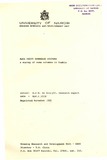| dc.description.abstract | Sanitation in c<;velooing countr~_es
The greatest challenge for the people concerned with
environmental health in developing countries is that of
water supply and excreta disposal systems in high density.
low-income urban co~munities. Recent statistics show that only
a minor part of the population lives in houses connected to
waterborne aewez aqe ,
Sanitary disposal methods in zambia (figures in percentages)
URBAN CENTRES LUSAI<A
1969 (1) 1974(2) 1976 (3) 1969(1) 1974 (2) 1976 (3)
Flush toilets 56,7 46.2 43,9 42.3 39,4 37.3
Aqua privy 7,0 5,4 5.5 2.9 1.4 1.2
Pit latrine 26,7 37,7 40.1 46.1 52.1 53,7
Bucket 2,1 1.5 1,3 6,5 3.1 2,7
None .2.t2 9,2 -.2.t..£ 2,2 -..!t~ 4,7
lOO"~ lOO"~ 100% 100% 100% 100%
These figures demonstrate the fact that whatever the official
poli~~ is, the proportion of dwellings with full services is
rapidly declining. Therefore, it seems that even When the
official policy is to provide full services for every individual
dwelling; in practice only a.small proportion of new dwellings
will enjoy these facilities.
The occupants of low income housing estates have often a
rudimentary or totally absent health education. and sometimes
these people have little comprehension of the reason for
sani tary pr ecaut.Lons , Therefore, thev do not have health
protective habits for urban living.
Consequently, the sanitary systems must provide security against
the possibility of ill-health as a result from mismanagement or
misuse of the system. An effic:er: sanitary system does not
necessarily mean a sophisticatt~,1.sy st.em, The provision of a
sanitary system beyond the technological competence of the
community could be a waste of money and effort.
Mechanical flushing systems (which require attention to the
waterlevel mechanism), U traps in toilets (which becon.e blocked
where toile~ paper is not common), and U traps in washing sinks
(where sand and porridge cause bloc~·:ages), can ruin tha
conventional waterborne system.
1. CSO Census of popu1.ation and housing 1969
2. J.T. Robertson "The urban situation Shelter" 1974.
3. Estimate made by Ministry of local Government and Housing.
Figures are not strictly comparable due to boundary changes
in Lusaka 3nd in urban are.as.
-2-
We also must not forget the environmental hazards involved and
the increased water consumption for a toilet system. In a low
income housing estate the user converts daily around 40 litres
of clean drinking water. about 5~~ of his total consumption.
into pathogenic matter which even in an expensive treatment
cycle cannot be completely sterilized.
This deterioration of the existing situation can be prevented
or minimized only by the introduction of an "appropriate
iDfc4·r.rnediate"solution, which can be afforded both by the
nation and by householders and which can be provided at a rate
consistent with that of urban growth.
The aqua-privy sewerage can be one of the solutions in this
field.
The following literature mentions the Zambian solution:
Disposal of community waste water WHO Technical Report ~o.541
Rural sanitation in the tropics The Ross Institute
Waste Stabilization Ponds WHO publication Gloyna
Sewage Treatment in hot climates D. Mara
Stop the Faeceal Peril lDRe report
Water Waste and Health in hot
climates by Feachem. M. l-1c Garry and
D. Mara
A system of sanitation for low- .
cost high den3ity housing by L.J. Vincent. W.E. Algie and G. Marias | en_US |



